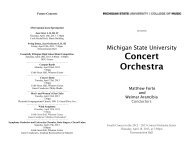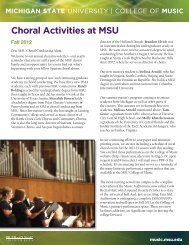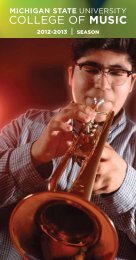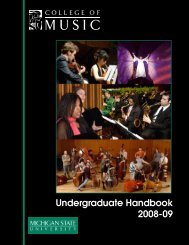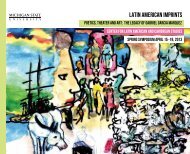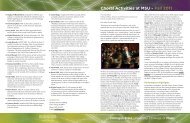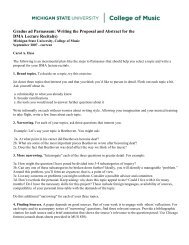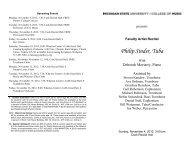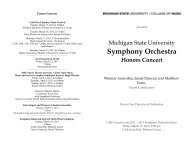DMA Document Proposal Example #2 - MSU College of Music
DMA Document Proposal Example #2 - MSU College of Music
DMA Document Proposal Example #2 - MSU College of Music
Create successful ePaper yourself
Turn your PDF publications into a flip-book with our unique Google optimized e-Paper software.
2pitches to the diatonic collection. The inextricable bond between neoclassicism and Stravinskyis discussed by Joseph Straus, Eric Salzman and Mosco Carner. 5The most complete analysis <strong>of</strong> the First Symphony is by Gertruida Steyn. 6 She examinesthe work’s construction, cites contemporaneous and current criticism, and discussesneoclassicism as relevant to Lutosławski’s early period. Both Charles Rae and Steven Stuckyanalyze sections <strong>of</strong> the First Symphony, focusing on Lutosławski’s chord structures and use <strong>of</strong>canon. 7 In their respective writings, Rae and Stucky argue against applying “neoclassicism” tothe symphony, each saying that this work is too modern to warrant the label. 8 Stefan Jarocinskiand Arnold Whittall acknowledge the problems the term creates but do not <strong>of</strong>fer any argumentfor or against its use. 9 In a 1974 interview with Bálint Varga, Lutosławski himself speaks <strong>of</strong> thecomposers who influenced his early pieces, though without recourse to “neoclassicism.” 10 Themajor proponent <strong>of</strong> neoclassicism in relation to Lutosławski’s music is Jadwiga Paja-Stach, whocites sections <strong>of</strong> the First Symphony as examples <strong>of</strong> neoclassical counterpoint. 11 In a separatepublication she provides a more detailed description <strong>of</strong> neoclassicism in Lutosławski’s worksbut fails to include the symphony. 12 Lutosławski’s connection with neoclassicism in popularprint is evidenced by John Rockwell’s article for The New York Times. 134 Scott Messing, Neoclassicism in <strong>Music</strong>: From the Genesis <strong>of</strong> the Concept Through the Schoenberg/StravinskyPolemic (Rochester, NY: University <strong>of</strong> Rochester Press, 1996), 106-17.5 Joseph N Straus, Remaking the Past (Cambridge, MA: Harvard University Press, 1990), 1-20; Eric Salzman,Twentieth-Century <strong>Music</strong>: An Introduction (Englewood Cliffs, NJ: Prentice-Hall, Inc., 1967), 45-59; and MoscoCarner, “<strong>Music</strong> in the Mainland <strong>of</strong> Europe: 1918-1939,” In The New Oxford History <strong>of</strong> <strong>Music</strong>, vol. 10, edited byMartin Cooper, 208-10 (London: Oxford University Press, 1974) 217-22.6 Steyn, “The Evolution <strong>of</strong> Witold Lutosławski’s Style,” 1-191.7 Charles Bodman Rae, The <strong>Music</strong> <strong>of</strong> Lutosławski, 25-33; Steven Stucky, Lutosławski and His <strong>Music</strong>, 23-33.8 Rae, The <strong>Music</strong> <strong>of</strong> Lutosławski, 25; Stucky, Lutosławski and His <strong>Music</strong>, 33.9Stefan Jarocinski, “Polish <strong>Music</strong> After World War II,”248; Arnold Whittall, “Between Polarity and Synthesis,”258.10 Bálint András Varga. Lutosławski Pr<strong>of</strong>ile: Witold Lutosławski in Conversation with Bálint Adrás Varga(London: Chester <strong>Music</strong>, 1976), 15-20.11 Jadwiga Paja, “The Polyphonic Aspect <strong>of</strong> Lutosławski’s <strong>Music</strong>.12 Jadwiga Paja-Stach, “The Stylistic Traits <strong>of</strong> Lutosławski’s Works,” 269-74.13John Rockwell, “Appreciating a European Avant-Gardist,” New York Times, March 18, 1979, D29.


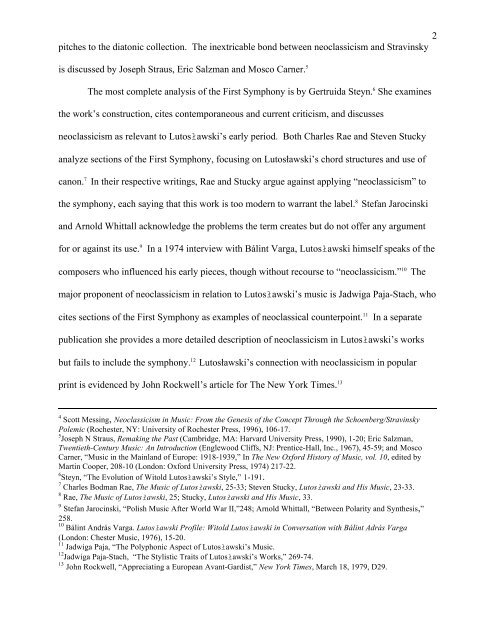

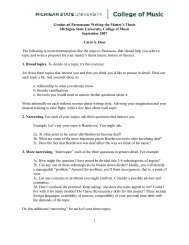
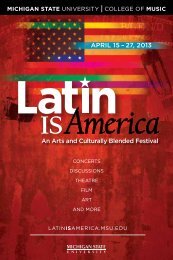
![evaluation form [PDF] - MSU College of Music - Michigan State ...](https://img.yumpu.com/48155330/1/190x245/evaluation-form-pdf-msu-college-of-music-michigan-state-.jpg?quality=85)
